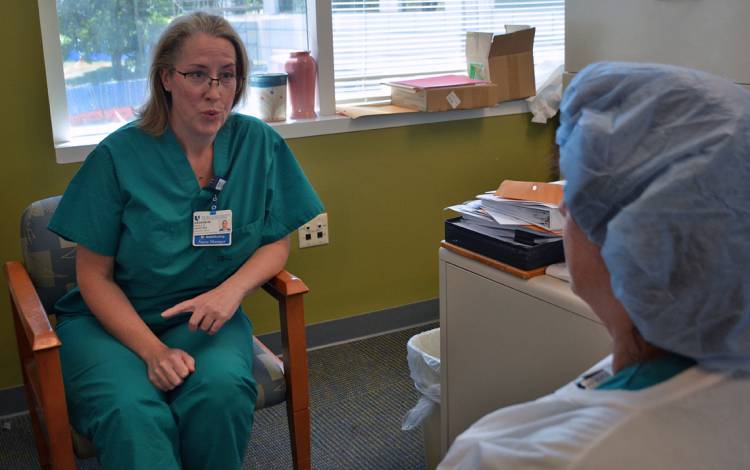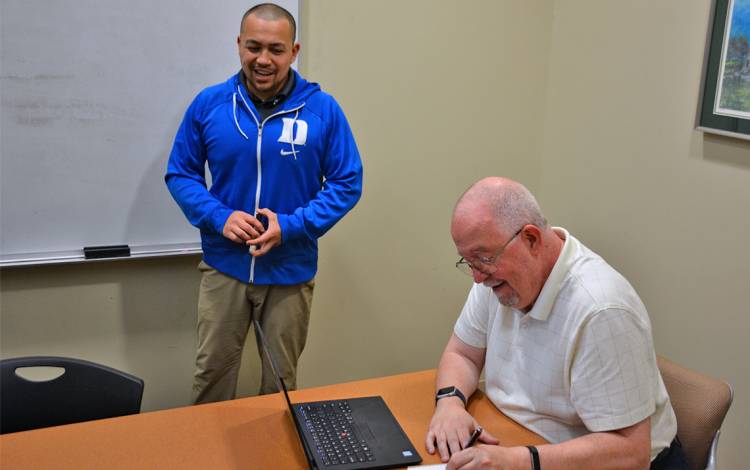How to Practice Active Listening
Maintain eye contact, withhold judgment and leave distractions behind

One of Jay Gallman’s colleagues sat across from him in a meeting room recounting a trip to Ireland. Or was it Iceland? England? Gallman wasn’t fully listening.
Gallman’s thoughts drifted over lunch options until Don Shortslef, a senior practitioner for Duke’s Learning & Organization Development (L&OD), called time on the exercise. The activity, part of Shortslef’s professional development class, “Communicating with Diplomacy & Tact,” revealed how challenging it can be to pay full attention during a conversation.
“It was a powerful exercise to show the importance of actively listening to whoever you’re talking to,” said Gallman, a risk and compliance IT analyst for the Duke Office of Information Technology (OIT). “You really don’t retain anything unless you’re focusing on the conversation.”
Active listening, a key lesson in Shortslef’s L&OD course, is the technique of fully concentrating, reflecting, clarifying, summarizing, sharing and withholding judgment.
“Listening is a key aspect of communication that is easy to overlook,” Shortslef said. “When someone comes to us with an issue or problem, we immediately want to react without really listening to them. Active listening means listening with effort, empathy and attention.”
Try these practices during your next conversation.
Leave distractions out of sight

As a nurse manager, Paula Angevine oversees a team of nearly 40 people in the operating room for the Duke Ambulatory Surgery Center.
When a team member wants to meet with her, she knows time is limited, but she wants to provide her full attention. Angevine moves from behind a desk and sits closer to colleagues. The computer screen is off, and her phone is out of sight.
“If someone is setting aside time to talk to me, I know it’s important to them,” Angevine said. “I want my entire focus on them. I can’t do that if my email is pulled up or my phone is buzzing.”
Angevine learned to remove distractions from the “Communicating with Diplomacy & Tact” course shortly after becoming a manager last summer.
“I learned to be mindful of the person who’s talking,” Angevine said. “I listen rather than think about how I’m going to respond.”
Be mindful of body language

Active listening is about your physical state as much as it is about an open mind.
Shortslef, the senior practitioner for L&OD, reviews the “7-38-55 Rule of Personal Communication” in his course. The rule, popularized by the University of California at Los Angeles Professor Emeritus Albert Mehrabian, states that spoken words account for 7 percent of personal communication, tone is 38 percent and body language is 55 percent.
Shortslef said the “7-38-55 Rule” exemplifies how important it is to display positive and engaged body language when speaking with someone.
“I could greet you with all of the vigor in the world, but if I’m rolling my eyes, my message takes on a whole new meaning,” Shortslef said. “Body language completely changes the context.”
He recommends the listener sit close and face the speaker, incline their head toward the person and hold eye contact. It’s important for a listener to lean their body toward their conversation partner.
“If I lean back in my chair when you’re trying to speak to me, it comes across like I don’t have much interest in the conversation,” Shortslef said. “Body language is an easy way to show you’re engaged and attentive.”
Ask questions to clarify

Jay Gallman, a risk and compliance IT analyst for OIT, often restates what he’s heard by beginning with “If I understand you correctly.”
In his role, Gallman meets with Duke employees to ensure research projects and their data are properly secured against cyber threats and that they follow applicable federal, state and University regulations. He wants to clearly understand the purpose of a project, so that everything is represented correctly when compliance plans are written.
“I summarize what is said in the meeting to verify everyone is on the same page,” he said. “I want to make sure I’m making the best use of everyone’s time and processing the information correctly.”
To help clarify issues, Shortslef said it’s beneficial to come to conversations with open-ended questions. It demonstrates interest and ensures topics get addressed.
“Writing down questions ahead of time means you’re not thinking about what you’re going to ask when the other person is talking,” Shortslef said. “You stay in the present.”
Communicating with Diplomacy & Tact Level 1 is offered in July, September and November. Level 2 is offered in August and October. See here for more information and offerings.
Have a story idea or news to share? Share it with Working@Duke.